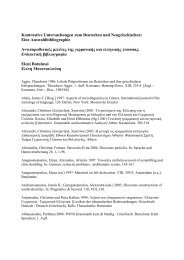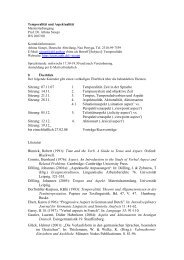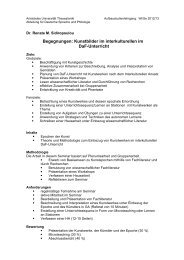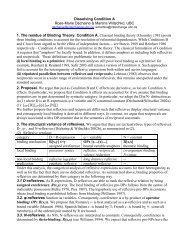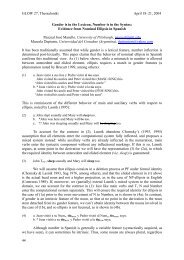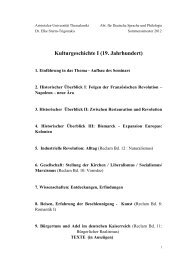Anna Cardinaletti (Venice) and Ur Shlonsky
Anna Cardinaletti (Venice) and Ur Shlonsky
Anna Cardinaletti (Venice) and Ur Shlonsky
You also want an ePaper? Increase the reach of your titles
YUMPU automatically turns print PDFs into web optimized ePapers that Google loves.
Main Session Abstracts<br />
part of the lexical or VP domain (vP or a like projection). (5) schematizes the two clitic<br />
positions.<br />
(5) [FP … [FP clitic [FP … [FP … [FP clitic [vP [VP ]]]]].<br />
|______________________| |_____________|<br />
functional domain lexical domain<br />
2. Italian lexical infinitives invariably display a word-final [e]. [e] is obligatorily absent in the<br />
presence of an enclitic pronoun, as in (6b).<br />
(6) a. Le vorrei parlare b. Vorrei parlar(*e)le<br />
(I) to her would want (to) speak (I) would want (to) speak to her<br />
There is no phonological motivation for this apparent truncation. The rule of Troncamento<br />
- which deletes a word-final /e/ or /o/ before a consonant-initial word if the target vowel is<br />
preceded by a sonorant consonant, (Peperkamp 1997) – is optional. The absence of [e] in (6b)<br />
is obligatory. We argue that the infinitive-final [e] is a morpheme. Indeed, it is the realization<br />
of the same low position which clitics target in e.g. (1a), (2a), <strong>and</strong> (3a). Although it appears<br />
that the final [e] is deleted in (6b), we argue that it is actually there, as the final vowel of the<br />
clitic le. The morphological makeup of parlarle is thus parlar-l-e. The clitic adjoins to the [e],<br />
which realizes the lexical clitic position. In fact, the underlying form of the infinitive-final<br />
vowel is /i/, as is the final vowel of the clitics mi, ci, vi etc. The [i]~[e] alternation is<br />
phonologically conditioned: /i/ [e] following a coronal sonorant. This rule lowers /e/ to [i]<br />
following the stem-final /r/ in infinitives.<br />
Although [e] may be absent on clitic-less lexical infinitives in Troncamento contexts, it<br />
must be absent on modal <strong>and</strong> volitional predicates in their restructuring guise.<br />
(7) *Sarei voluto potere partire con Maria.<br />
Again, no phonological explanation is available for the absence of [e] in this context. We<br />
argue that [e] is absent from intermediate restructuring verbs for exactly the same reason that<br />
clitics cannot attach to them (as we saw in (4)). Compare (7) with (3b).<br />
3. Restructuring verbs are not a homogeneous class (see also Wurmbr<strong>and</strong> (forthcoming)). For<br />
example, causative <strong>and</strong> perception verbs (as well as motion verbs) are restructuring verbs that<br />
do not trigger auxiliary switch, (8b), can host a clitic, (8c), <strong>and</strong> display the infinitival [e], (8d).<br />
(8) a. L’ho fatto/visto partire. b. *Lo sono fatto/visto partire.<br />
(I) him have made/seen leave (I) him am made/seen leave<br />
c. Vorrei farlo leggere a Maria. d. Lo vorrei fare leggere a Maria.<br />
(I) would-want (to) make.it read to Maria<br />
4. There is a correlation between the properties displayed by restructuring verbs <strong>and</strong> their<br />
position in the functional hierarchy in (9) (cf. Cinque(forthcoming2004).) Modal <strong>and</strong><br />
volitional verbs appear highest in the hierarchy. The class of causative, perception <strong>and</strong> motion<br />
verbs - underlined in (9) - appear in the lower part of this hierarchy, below Voice <strong>and</strong> above<br />
the domain of “VP-adverbs”.<br />
(9) > Modvolition > … > Modobligation …> Mod permission …> Voice > Perception ><br />
Causative > … > Andative > Completive > … VP<br />
5. The difference between lexical verbs <strong>and</strong> the verbs underlined in (9), on the one h<strong>and</strong>, <strong>and</strong><br />
between these <strong>and</strong> the other restructuring verbs, on the other, is that they project shells of<br />
different sizes. Lexical verbs are endowed with a full shell, including vP <strong>and</strong> the lexical clitic<br />
or [e] position. In addition, lexical verbs select an auxiliary, the choice of which depends on<br />
the way the arguments are aligned in the shell. The verbs underlined in (9) are associated with<br />
a reduced shell, a fact which we relate to the limitations on their argument structure. Finally,<br />
the other restructuring verbs lack a shell altogether. These are simply merged in functional<br />
heads. To put it concisely, lexical verbs <strong>and</strong> the verbs underlined in (9) are associated with a<br />
richer structure than fully functional verbs. However, the split between lexical <strong>and</strong> functional<br />
verbs is not clear-cut. Rather, there is a gradation from structurally rich to structurally poor<br />
verbal representations.<br />
29



